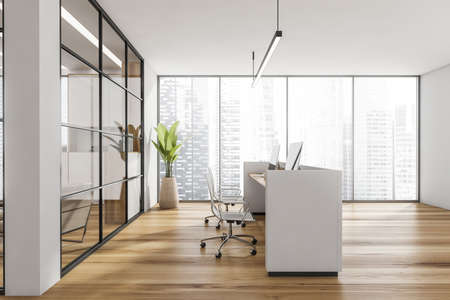Understanding Loft Conversions in Modern British Homes
In recent years, loft conversions have surged in popularity across the UK, particularly in urban centres where space is at a premium. British homeowners are increasingly seeking to maximise the potential of their properties by transforming underused attic spaces into functional living areas. This trend is especially pronounced within modern flats and heritage terraces, where extending outwards may not be feasible due to planning constraints or the desire to preserve architectural character. The integration of home offices into these converted lofts reflects a broader shift towards flexible working arrangements and the need for dedicated workspaces at home. When considering such adaptations, it’s essential to balance practical concerns—such as head height, access, insulation, and natural light—with the unique quirks of period properties or new-build apartments. Ultimately, a well-designed loft conversion not only adds value to a flat but also enhances day-to-day living by providing a tailored solution to contemporary work-life demands.
2. Key Considerations for Creating a Home Office in a Loft
Transforming a loft into a functional home office within a modern UK flat requires careful planning, especially given the unique characteristics of British homes and climate. Below, we delve into the essential elements—structural integrity, lighting, and insulation—that ensure your loft workspace is both comfortable and productive all year round.
Structural Requirements: Safety First
The first step in any loft conversion project is to assess and reinforce the existing structure. Lofts in many UK properties were not originally designed to bear significant loads, particularly those associated with furniture and daily use as an office. Consulting a structural engineer is highly advisable; they can evaluate whether additional supports or steel beams are necessary to meet current building regulations. Ensuring proper access—such as fitting a staircase that complies with British standards—is also crucial for both safety and convenience.
Lighting: Maximising Natural and Artificial Sources
Effective lighting is paramount when designing a home office in a loft, especially given the often grey British weather. Making use of natural light can boost productivity and well-being. Consider installing Velux windows or dormers to increase daylight exposure. However, artificial lighting remains essential, particularly during short winter days. Layered lighting—combining overhead LEDs, desk lamps, and ambient fixtures—ensures an even spread of light without harsh shadows or glare on screens.
| Lighting Type | Purpose | Best Practices for UK Lofts |
|---|---|---|
| Natural (Velux/Dormer) | General illumination & mood enhancement | Position windows to maximise south-facing light where possible |
| Overhead LED | Main task lighting | Choose daylight bulbs; avoid single-point sources to reduce shadows |
| Desk Lamp | Focused work area lighting | Select adjustable models with cool white bulbs for reading or computer work |
| Ambient/Accent Lighting | Mood and comfort | Add dimmable wall lights or floor lamps for evening flexibility |
Insulation: Staying Comfortable Year-Round
The UKs variable climate makes effective insulation absolutely vital in any loft conversion used as a workspace. Inadequate insulation can lead to sweltering summers and freezing winters under the eaves, directly impacting comfort and productivity. High-quality roof insulation—such as rigid PIR boards or multi-layer reflective materials—can significantly improve thermal performance. Don’t neglect draught-proofing around new windows and ensuring adequate ventilation to prevent condensation or damp issues.
| Insulation Area | Recommendation | Benefit for Home Office Use |
|---|---|---|
| Roof Slopes | PIR rigid boards or multi-foil layers between rafters | Keeps office warm in winter, cool in summer; energy savings |
| Walls (if exposed) | Semi-rigid insulation batts behind plasterboard finishings | Dampens external noise; stabilises temperature fluctuations |
| Floors/Access Points | Add carpet or underlay; seal hatch gaps | Muffles sound transfer; prevents heat loss via gaps or stairs |
| Windows/Glazing | Double-glazed units; tight-fitting seals/draught excluders | Reduces heat loss; minimises condensation risk during colder months |
The Importance of Tailoring Design to UK Conditions
A successful loft home office isn’t just about aesthetics—it’s about creating a space that stands up to the quirks of British weather while meeting practical needs for daily work. By focusing on robust structural support, strategic lighting solutions, and thorough insulation, you lay the groundwork for a truly productive environment within your modern flat.

3. Design Ideas for Work-Friendly Loft Offices
Creating a home office within a loft conversion presents a unique opportunity to blend practicality with the distinctive character of British homes. Successful designs maximise available space, harness natural light, and ensure comfort without compromising the charm of period features or modern aesthetics.
Maximising Space in Loft Offices
Space is often at a premium in loft conversions, particularly in urban flats. Built-in desks and bespoke shelving units that follow the eaves make clever use of awkward angles, freeing up floor area for movement. Foldaway workstations or modular furniture also allow the office to adapt as needs change, keeping the environment flexible and uncluttered.
Harnessing Natural Light
Natural light is essential for productivity and wellbeing. Consider installing Velux windows or dormer extensions to flood the workspace with daylight. Positioning your desk beneath a skylight can create an uplifting atmosphere while reducing reliance on artificial lighting. For privacy and glare control, opt for adjustable blinds in muted tones that complement the existing décor.
Comfort Without Compromise
Comfort is key to any home office. Ergonomic chairs and height-adjustable desks support healthy posture during long working hours. Underfloor heating or discreet radiators ensure warmth without taking up valuable wall space. To maintain acoustic comfort, especially in terraced houses or busy city locations, soundproofing measures like insulated plasterboard or soft furnishings can be incorporated seamlessly into your design.
Maintaining Character in British Homes
A successful loft office respects the character of its setting. Retain exposed beams, original brickwork, or period cornicing where possible, integrating these features into your scheme rather than concealing them. Contemporary colour palettes—think sage greens, deep blues, or warm neutrals—can freshen the space while echoing classic British taste. Thoughtful lighting fixtures and vintage-inspired accessories help bridge old and new for a workspace that feels distinctly ‘home’.
Utility Meets Aesthetics
Finally, utility should never come at the expense of aesthetics. Clever cable management systems keep technology tidy, while hidden storage solutions prevent paperwork from overwhelming the room’s visual appeal. Incorporate plants and artwork to personalise your office and promote wellbeing—small touches that can make all the difference when working from home becomes part of daily life.
4. Incorporating Storage and Organisation Solutions
Making the most of limited loft space is essential when designing a home office that supports productivity and comfort. Effective storage and organisation solutions not only help to keep your workspace tidy but also create a visually appealing environment that makes working from home in a converted loft both practical and enjoyable.
Smart Storage for Compact Spaces
Loft conversions in UK flats often come with sloped ceilings, awkward nooks, and limited floor area. It’s crucial to select storage options that maximise every inch without overwhelming the room. Built-in shelving along the eaves or alcoves takes advantage of otherwise wasted space, while custom-made cupboards under low ceilings can provide discreet storage for office supplies and documents.
Shelving Ideas for Lofts
| Type of Shelving | Best Use Case | Installation Tips |
|---|---|---|
| Floating Shelves | Display books, plants, and small decor | Mount above desk areas or along unused wall sections |
| Bespoke Alcove Units | Maximise storage in odd-shaped corners | Measure carefully to fit around sloped ceilings |
| Under-Desk Drawers | Store stationery, files, and tech accessories | Opt for slimline designs to save legroom |
| Modular Cube Storage | Flexible arrangement for mixed items | Stack vertically where ceiling height allows |
Cable Management Solutions
The modern home office requires multiple electronic devices, which inevitably means cables. In compact lofts, visible wiring can quickly make the space look cluttered and disorganised. Use cable trays mounted underneath desks, adhesive cable clips along skirting boards, or even integrated cable ports within built-in furniture to keep wires out of sight. Where possible, opt for wireless devices to minimise cabling altogether.
Tidy Desk Habits for Small Offices
Cultivating good organisational habits is as important as having the right storage solutions. Assign a place for everything—use labelled baskets or magazine files for paperwork, invest in desktop organisers for pens and gadgets, and clear your workspace at the end of each day. Not only does this maintain order, but it also helps create a calm atmosphere conducive to focused work.
By integrating clever storage, tailored shelving, and effective cable management into your loft conversion home office, you’ll create a streamlined environment suited to modern working life in British flats—no matter how limited the space.
5. Ensuring Connectivity and Modern Amenities
When transforming a loft space into a functional home office, reliable connectivity and up-to-date amenities are absolutely crucial. Many converted lofts in the UK are located at the top of period properties, which can present unique challenges for integrating modern technology. To begin with, high-speed internet access is non-negotiable for contemporary work-from-home arrangements. Consider running dedicated Ethernet cabling to the loft or investing in mesh Wi-Fi systems to avoid patchy signals that often plague upper floors in older buildings. Consulting a professional during the renovation phase can help ensure seamless connectivity without unsightly wires trailing across your new workspace.
Power Supply: Safe and Sufficient Outlets
A typical home office setup demands more power outlets than a traditional bedroom or spare room. Think ahead about the number and location of sockets—plan for computers, monitors, printers, lamps, and phone chargers. Upgrading the electrical supply may be necessary to support increased demand safely. If you’re working with an electrician, specify double sockets at desk height along key walls for convenience. In addition, consider surge protection to safeguard sensitive equipment from unexpected power fluctuations common in older British homes.
Heating and Comfort
Loft spaces are notorious for their temperature extremes—chilly in winter and stifling in summer. Effective insulation is essential, but so is a modern heating solution that doesn’t eat into valuable floor area. Slimline electric radiators or underfloor heating are popular choices for UK conversions, offering warmth without cluttering the room. Programmable thermostats allow you to maintain an ideal working environment regardless of season, ensuring productivity isn’t compromised by discomfort.
Integrating Smart Technology
For those looking to future-proof their workspace, incorporating smart home devices—such as app-controlled lighting, heating, and blinds—can elevate both comfort and energy efficiency. These additions not only contribute to sustainability goals but also add a layer of convenience that’s especially appreciated during long hours spent working from home. By addressing these requirements early in your loft conversion project, you guarantee a workspace that’s truly fit for purpose in today’s digitally connected world.
6. Navigating Planning Permission and Building Regulations
Successfully integrating a home office within a loft conversion in the UK involves more than just clever design – it requires a clear understanding of planning permissions and building regulations. While many loft conversions fall under Permitted Development Rights, which means formal planning permission may not always be needed, creating a dedicated workspace introduces specific legal considerations. If you intend to significantly alter the roof structure, extend the space, or your property is located within a conservation area or is a listed building, planning permission will almost certainly be required. Even if full planning permission isn’t necessary, all loft conversions must comply with current building regulations, especially regarding fire safety, insulation, structural integrity, and access.
Understanding Permitted Development Rights
Most standard loft conversions in houses (not flats) are covered by Permitted Development Rights, allowing homeowners to proceed without formal consent as long as certain conditions are met – such as not exceeding volume limits and keeping materials in character with the existing property. However, flats and maisonettes do not benefit from these rights; any conversion involving these properties always requires a formal application. Moreover, using your new loft space primarily as a home office does not automatically change its classification from residential use, but running a business that involves staff or clients visiting frequently might trigger additional requirements or restrictions.
Building Regulations: What You Must Address
Regardless of planning status, all loft conversions must meet UK building regulations. This ensures that the new home office is safe, energy-efficient, and structurally sound. Key areas include:
- Fire Safety: Adequate escape routes and smoke alarms are mandatory for all habitable rooms created in a loft.
- Insulation: Both thermal and sound insulation need to meet stringent standards to ensure comfort and efficiency.
- Access: Stairs must provide safe access; ladders are generally not acceptable for habitable spaces.
- Structural Stability: The floor must support increased loads typical of office furniture and equipment.
The Importance of Professional Guidance
Navigating these legal and technical aspects can feel daunting. Consulting with experienced architects or builders familiar with local council requirements is crucial for avoiding costly mistakes and delays. They can help interpret recent changes to legislation, manage application submissions if necessary, and liaise with Building Control inspectors throughout the process. Ultimately, ensuring compliance from the outset makes integrating your home office into a loft conversion both straightforward and stress-free.
7. Case Studies: Successful Loft Office Integrations in the UK
To provide practical inspiration, let’s delve into several real-world examples where British homeowners have successfully transformed their lofts into productive workspaces. These case studies illustrate how thoughtful design and creative solutions can make a significant difference in adapting modern flats for remote work.
Central London Flat – Maximising Limited Space
In a compact flat near King’s Cross, Sarah and David converted their underused loft into a dual-purpose office and guest room. By installing bespoke fitted furniture, including a fold-down desk and wall-mounted shelves, they maximised every inch of headroom. Skylights bring in ample daylight, while clever use of muted colours keeps the space feeling airy despite the restricted dimensions—a common challenge in central London homes.
Victorian Terrace in Manchester – Blending Heritage with Modern Needs
The Smith family wanted to respect the period features of their Victorian terrace while creating a contemporary workspace. They retained original exposed beams and added energy-efficient roof windows for natural light. The home office includes custom-built cabinetry matching the home’s style, ensuring that the new function blends seamlessly with the traditional architecture—an approach often seen in northern cities where heritage is valued.
Bristol Suburb – A Sustainable Approach
Environmentally conscious homeowner Tom from Bristol used reclaimed materials to build his loft office. Insulation made from recycled fibres keeps the space comfortable year-round, and solar tubes supplement natural lighting. Tom’s story highlights how sustainability can be integrated without compromising on comfort or aesthetics, aligning with growing eco-friendly trends across the UK.
Edinburgh New Town Flat – Overcoming Planning Hurdles
Planning regulations are strict in listed buildings such as those found in Edinburgh’s New Town. Anna worked closely with architects and local authorities to ensure her loft conversion met all requirements. Her office now boasts discreet built-in storage and innovative soundproofing, allowing her to work undisturbed within a bustling city setting. This example underscores the importance of compliance and creative problem-solving in historic districts.
Takeaway Lessons
These British case studies demonstrate that with careful planning, even small or challenging loft spaces can be transformed into highly functional home offices. Whether through bespoke joinery, sustainable materials, or sensitive restoration of period details, integrating workspaces into loft conversions is both achievable and rewarding for modern UK homeowners.

